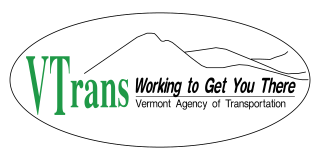Related Research Articles

A trail, also known as a path or track, is an unpaved lane or a small paved road not intended for usage by motorized vehicles, usually passing through a natural area. In the United Kingdom and Ireland, a path or footpath is the preferred term for a pedestrian or hiking trail. The term is also applied in North America to accompanying routes along rivers, and sometimes to highways. In the US, the term was historically used for a route into or through wild territory used by explorers and migrants. In the United States, "trace" is a synonym for trail, as in Natchez Trace.

The Georgia Department of Transportation (GDOT) is the organization in charge of developing and maintaining all state and federal roadways in the U.S. state of Georgia. In addition to highways, the department also has a limited role in developing public transportation and general aviation programs. GDOT is headquartered in downtown Atlanta and is part of the executive branch of state government.

The Federal Highway Administration (FHWA) is a division of the United States Department of Transportation that specializes in highway transportation. The agency's major activities are grouped into two programs, the Federal-aid Highway Program and the Federal Lands Highway Program. Its role had previously been performed by the Office of Road Inquiry, Office of Public Roads and the Bureau of Public Roads.

The Tennessee Department of Transportation (TDOT) is the department of transportation for the State of Tennessee, with multimodal responsibilities in roadways, aviation, public transit, waterways, and railroads. It was established in 1915 as the Tennessee Department of Highways and Public Works, and renamed the Tennessee Department of Transportation in 1972. The core agency mission of TDOT is to provide a safe and reliable transportation system for people, goods, and services that supports economic prosperity in Tennessee. Since 1998, TDOT has been ranked amongst the top five in the nation for quality highway infrastructure. It is primarily headquartered in downtown Nashville and operates four regional offices in Chattanooga, Jackson, Knoxville, and Nashville.

A Metropolitan Planning Organization (MPO) is a federally mandated and federally funded transportation policy-making organization in the United States that is made up of representatives from local government and governmental transportation authorities. They were created to ensure regional cooperation in transportation planning. MPOs were introduced by the Federal-Aid Highway Act of 1962, which required the formation of an MPO for any urbanized area (UZA) with a population greater than 50,000. Federal funding for transportation projects and programs are channeled through this planning process. Congress created MPOs in order to ensure that existing and future expenditures of governmental funds for transportation projects and programs are based on a continuing, cooperative, and comprehensive ("3-C") planning process. Statewide and metropolitan transportation planning processes are governed by federal law. Transparency through public access to participation in the planning process and electronic publication of plans now is required by federal law. As of 2015, there are 408 MPOs in the United States.

The Vermont Agency of Transportation (VTrans) is a government agency of the U.S. state of Vermont that is responsible for planning, constructing, and maintaining a variety of transportation infrastructure in the state. This includes roads, bridges, state-owned railroads, airports, park and ride facilities, bicycle facilities, pedestrian paths, public transportation facilities and services, and Department of Motor Vehicles operations and motor carrier enforcement.
The Low Income Home Energy Assistance Program is a United States federal social services program first established in 1981 and funded annually through Congressional appropriations. The mission of LIHEAP is to assist low income households, particularly those with the lowest incomes that pay a high proportion of household income for home energy, primarily in meeting their immediate home energy needs. The program, part of the United States Department of Health and Human Services (HHS), is funded by grants appropriated from the federal government.

The Michigan Department of Natural Resources (DNR) is the agency of the state of Michigan founded in 1921, charged with maintaining natural resources such as state parks, state forests, and recreation areas. It is governed by a director appointed by the Governor and accepted by the Natural Resources Commission. Since 2023, the Director is Scott Bowen. The DNR has about 1,400 permanent employees, and over 1,600 seasonal employees.
The Massachusetts Department of Transportation (MassDOT) oversees roads, public transit, aeronautics, and transportation licensing and registration in the US state of Massachusetts. It was created on November 1, 2009, by the 186th Session of the Massachusetts General Court upon enactment of the 2009 Transportation Reform Act.

The Nebraska State Highway System consists of all the state highways in Nebraska maintained by the Nebraska Department of Transportation. This includes federally designated Interstates and US Highways as well as state highways, links and spurs. The system comprises 9,942 miles (16,000 km) of state highways in all 93 counties. Highways within the system range in scale and quality from 10-lane urban freeways, such as I-80 around Omaha, to standard two-lane rural undivided highways as well as 39 miles (63 km) of state highways that remain unpaved such as N-67 north of Dunbar. Surrounding landscapes along the highway system range from the urban areas in Omaha and Lincoln to scenic journeys through uninhabited grasslands in the Nebraska Sandhills.
The H-GAC 2035 Regional Transportation Plan is the long range transportation plan for the Houston-Galveston Area and serves as blueprint for further planning to be undertaken in the region over the next 30 years. The plan which was developed in a joint cooperation with Cities, Counties, Texas Department of Transportation (TxDOT) and METRO. The RTP combines research, plans and programs by various organizations into one comprehensive plan which is updated every four years. The RTP's main aim is to identify long-range transportation needs, prioritize programs and projects and to provide a forum for dialogue and regional problem solving.
There are approximately 25 current toll roads in the state of Texas. Toll roads are more common in Texas than in many other U.S. states, since the relatively low revenues from the state's gasoline tax limits highway planners' means to fund the construction and operation of highways.

The Federal Aid Road Act of 1916, Pub. L.Tooltip Public Law 64–156, 39 Stat. 355, was enacted on July 11, 1916, and was the first federal highway funding legislation in the United States. The rise of the automobile at the start of the 20th century, especially after the low-price Ford Model T in 1908, created a demand for better roads on a national level. The act provided federal subsidies to road-building efforts.

The Mass Transportation Authority (MTA) is the public transit operator serving Flint, Michigan and surrounding Genesee County. It also owns and operates the inter-modal Flint station, which also serves Amtrak and Indian Trails.
Cumberland Valley Rail Trail (CVRT) is a National Recreation Trail rail trail that follows the former Cumberland Valley Railroad corridor for 9.5 miles in Cumberland County, Pennsylvania. CVRT travels through the farmlands from Shippensburg to Newville.
Urban freight distribution is the system and process by which goods are collected, transported, and distributed within urban environments. The urban freight system can include seaports, airports, manufacturing facilities, and warehouse/distribution centers that are connected by a network of railroads, rail yards, pipelines, highways, and roadways that enable goods to get to their destinations.

The Moving Ahead for Progress in the 21st Century Act (MAP-21) is a funding and authorization bill to govern United States federal surface transportation spending. It was passed by Congress on June 29, 2012, and President Barack Obama signed it on July 6. The vote was 373–52 in the House of Representatives and 74–19 in the Senate.

The Lebanon Valley Rail Trail (LVRT) is a National Recreation Trail. The rail trail goes from the southwestern border of Lebanon County and goes through Colebrook, Mt. Gretna, Cornwall, and the city of Lebanon. At the southern border of Lebanon County, Pennsylvania the LVRT connects with the Conewago Recreation Trail and continues for another 5.0 miles (8.0 km). The trail is partly built on the old Cornwall–Lebanon Railroad created by industrialist Robert H. Coleman in the 1880s. The trail runs 15.0 miles (24.1 km), and there are many phases in development that would extend the trail to northern Lebanon County and Jonestown. The trail features a packed stone path and paved path at many parts that traverses "Pennsylvania Dutch Country" and other scenic routes. Trail users see untouched woodlands of state gamelands, forests, and views of area fields and farms. The trail is maintained by dedicated group of volunteers, and allows for running, walking, biking, horseback riding, and cross-country skiing.

The San Francisco Bay Area Water Trail is a growing network of launch and landing sites that allow people in non-motorized small boats and beachable sail craft such as kayaks, canoes, dragon boats, stand up paddle and windsurf boards, to safely enjoy San Francisco Bay through single and multiple-day trips. The Water Trail is enhancing Bay Area communities’ connections to the Bay and creating new linkages to existing shoreline open spaces and other regional trails as well as increasing education about personal safety, navigational safety, and appropriate boating behavior near sensitive wildlife species and shoreline habitat. The Water Trail is implemented under the leadership of the California Coastal Conservancy in close collaboration with the Association of Bay Area Governments, the San Francisco Bay Conservation and Development Commission, and the California Department of Boating and Waterways.

The Willapa Hills Trail is a 56.0-mile (90.1 km) intercounty rail trail in the U.S. state of Washington that is part of the Willapa Hills State Park. Following an east–west route alongside State Route 6, the tract links Chehalis and South Bend, traveling through or near several small towns and parks along the way. Overseen by the Washington State Parks and Recreation Commission, local cities and towns often maintain areas of the trail within their jurisdictions. The trail is built upon a decommissioned railroad track.